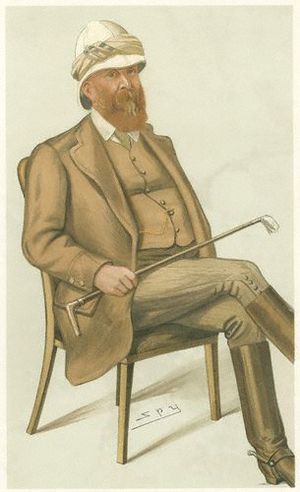Peter Lumsden facts for kids
Quick facts for kids
Sir Peter Stark Lumsden
|
|
|---|---|

Lumsden circa 1879
|
|
| Born | 9 November 1829 Belhelvie, Aberdeenshire |
| Died | 9 November 1918 (aged 89) Dufftown, Banffshire |
| Allegiance | |
| Service/ |
|
| Years of service | 1847–1887 |
| Rank | General |
| Battles/wars | Indian Rebellion of 1857 Second Opium War Bhutan War Second Anglo-Afghan War |
| Awards | Knight Grand Cross of the Order of the Bath Companion of the Order of the Star of India Mentioned in Despatches (6) |
| Relations | Harry Burnett Lumsden |
| Other work | Justice of the peace |
General Sir Peter Stark Lumsden (9 November 1829 – 9 November 1918) was an important British military officer. He spent most of his career serving in India. Born in Belhelvie, Aberdeenshire, Scotland, he was one of six sons.
Lumsden joined the army in 1847 as an ensign, which is a junior officer rank. He served on the North-West Frontier in India. There, he helped put down the Indian Rebellion of 1857 and captured a rebel leader named Tantya Tope. He also fought in the Second Opium War in China and the Bhutan War.
Later, he became an Adjutant-General for the Indian Army. He even worked for Queen Victoria as an aide-de-camp, which means he was a personal assistant. Sir Peter Lumsden was recognized for his service with high honors, including the Knight Grand Cross of the Order of the Bath. After retiring, he became a justice of the peace in his home county. He passed away on his 89th birthday.
Contents
Life and Military Adventures
Early Days and Frontier Service
Peter Stark Lumsden was born on November 9, 1829, in Belhelvie, Scotland. He went to Addiscombe Military Seminary to train for the army. In 1847, at age 18, he joined the East India Company's army in India. He started as an ensign in the 60th Bengal Native Infantry.
From 1852 to 1857, Lumsden served on the North-West Frontier. He took part in five missions against local tribes. His bravery was noted five times, and he received special thanks from the government.
In 1857, he went on a peace mission to Kandahar with his brother, Harry Lumsden. After that, he returned to India to help stop the Indian Rebellion of 1857. He joined forces under General Sir Robert Napier. As an assistant quartermaster general (a role that manages supplies and movements), he helped chase and capture Tantya Tope in 1859.
Wars in China and Bhutan
Lumsden's next big assignment was during the Second Opium War in China in 1860. He served as a quartermaster general for General Napier's forces. He helped the British and French armies in their operations. This included capturing Tang-ku and the Taku Forts. These actions led to the occupation of Beijing.
His service in China earned him more recognition. He was promoted to brevet-Major and then brevet-lieutenant-colonel. A "brevet" rank is a temporary higher rank given for good service.
Lumsden's last active combat was in the Bhutan War of 1865. After this, he worked in staff and political roles. He was a deputy quartermaster general and then the quartermaster general of the Indian Army. From 1874 to 1879, he was the Adjutant-General for India. This role is like a chief administrative officer for the army. He also spent eleven years as an aide-de-camp to Queen Victoria. This meant he was a personal assistant to the Queen.
Serving in Afghanistan and Beyond
Lumsden was the Chief of Staff for General Sir F. P. Haines during the Second Anglo-Afghan War. For his work, he received the Order of the Bath, a special award.
In 1884, Lumsden returned to the North-West Frontier. He was chosen to represent Britain on the Anglo-Russian Commission. This group was tasked with drawing the border between Afghanistan and Russia. He felt the British government's instructions were not clear enough. This made the situation very risky, almost leading to war with Russia.
He resigned and went back to England in 1885 after an event called the Panjdeh Incident. He then helped with negotiations with Russia to finalize the Afghan border.
In 1883, Lumsden was given the high honor of Knight Grand Cross of the Order of the Bath. He also became a commissioner on the Council of India for ten years. In 1885, he wrote an article about the lands and tribes near the Koh-i-Baba Range.
Later Life and Family
After his time on the Council of India, Lumsden retired from the military in 1893. He bought an estate called Buchromb near Dufftown, Scotland. He also co-wrote a book called Lumsden of the Guides. This book was about his brother, Harry Burnett Lumsden. It explained his brother's role in starting The Corps of the Guides, a famous Indian Army regiment.
Sir Peter Lumsden was involved in local community affairs. He served as a justice of the peace, which is a local judge. He also served as a Deputy Lieutenant for Banffshire and Aberdeenshire. Sir Peter Lumsden passed away on November 9, 1918, at his home in Dufftown.
Lumsden married Mary Marriott in 1862. His father, Colonel Thomas Lumsden, was also a distinguished officer. Thomas Lumsden had served in the Gurkha War and other campaigns. Peter's father and his uncle, Harry Lumsden, were both important figures in their family. Peter and his brother Harry followed their father into military careers in India.


